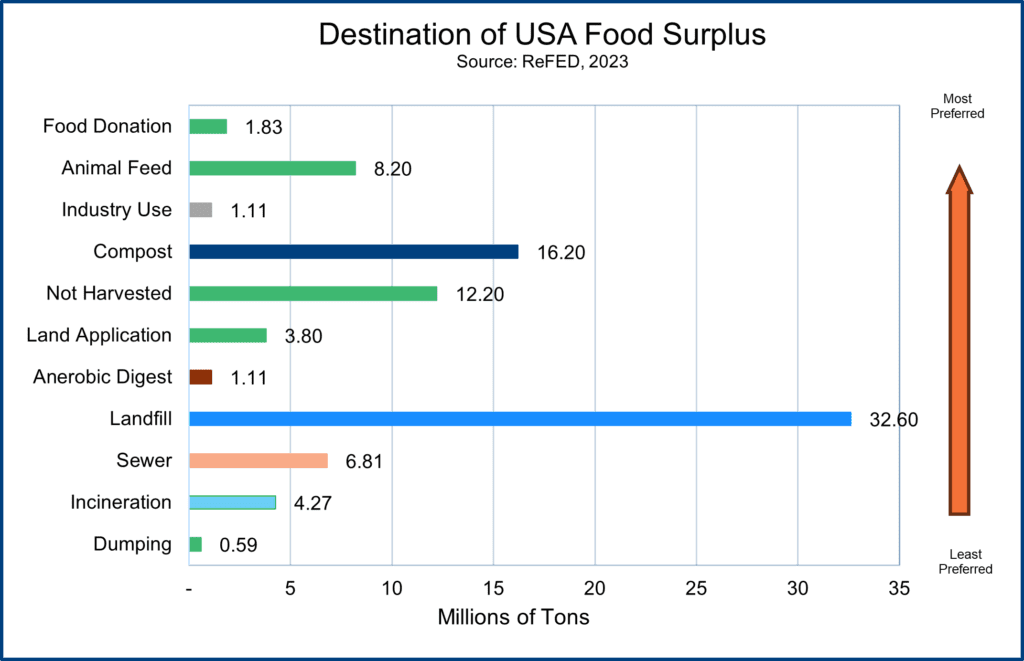
Apr 04, 2024 The Food Waste Challenge
In a critical step towards global sustainability, the United Nations (UN) adopted seventeen Sustainable Development Goals(SDGs) in 2015. SDG12 addressed consumption and production. Its third indicator target (SDG 12.3) focused on food waste and loss. The UN set a target of halving food waste by 2030 (during retail and consumption) and called for an unspecified reduction in food lost during harvest and distribution.
SDG 12.3 matters because the food lost and wasted generates additional greenhouse gas emissions, is grown using water and fertilizers, and uses land that could be devoted to sustaining biodiversity. In addition, lost and wasted food is not available for the hundreds of millions of people suffering from undernourishment.
Current Context:
Global
The United Nations Environment Program (UNEP) updated its 2021 Food Waste Index Report in March 2024. The opening paragraph of the UNEP Report succinctly captures the food waste challenge.
“Food waste is a market failure that results in the throwing away of more than US $1 trillion worth of food every year. It is also an environmental failure: food waste generates an estimated 8–10 percent of global greenhouse gas emissions (including from both loss and waste), and it takes up the equivalent of nearly 30 percent of the world’s agricultural land. The conversion of natural ecosystems for agriculture has been the leading cause of habitat loss. Just as urgently, food waste is failing people: even as food is being thrown away at scale, up to 783 million people are affected by hunger each year, and 150 million children under the age of five suffer stunted growth and development due to a chronic lack of essential nutrients in their diets.”
The UNEP Report distinguishes between food waste and food loss. Food waste refers to discarded food (both edible and inedible parts1, unsold and uneaten) that can be consumed at the retail and consumption levels. In contrast, food loss applies to food lost during production, storage, processing, and distribution. The UNEP Report, published on March 27, focuses on food waste.
The Report includes data on food waste from 93 countries, 41 more than in the 2021 edition. It is estimated that 1.05 billion tonnes of food was wasted in 2022 (or around 19% of all food available to consumers). Household food waste amounted to 60% of the total, with the food service sector responsible for 27.6% and retail for 12.4% of food waste. This “waste” is in addition to the 13% of food “lost” in the global food supply chains before reaching retail outlets.
The waste of food is not just a problem for global food security. The production of food that is wasted and lost has environmental consequences. Wasted food requires fresh water and is responsible for additional (8-10%) greenhouse gas emissions and driving reductions in biodiversity. The 2024 UNEP Report also noted that food waste is not limited to rich countries. High-income countries differ from medium-income countries in the amount of food wasted by only 7kg of food waste per capita per year.
Further understanding of food waste is gained by understanding the connection between food supply and food waste.
What is Happening in the USA
In the USA, ReFED estimated that the food surplus, food not sold or eaten, was 38% (88.7 million tons) of all food produced in 20222. While some of that surplus is donated for human consumption, animal feed, and industrial use, the vast majority, 87%, is considered food waste. In other words, approximately 33% (77.58 million tons) of the food produced is wasted. Please refer to the graph to track the USA’s food surplus destinations. About 37% (32.60 million tons) of wasted food is in landfills2, producing methane, a potent greenhouse gas. Food waste is the most significant single municipal solid waste component (24%)3. Globally, reducing food waste has been identified as a critical Sustainable Development Goal (SDG 12.3).
The US Department of Agriculture (USDA) and the Environmental Protection Agency (EPA) called in 2015 for a 50% reduction in food waste in the USA by 2030 to improve overall food security and the conservation of national resources 4. The agreement between the two agencies emphasizes the importance of source reduction (that is, reducing the amount of food produced to match demand more closely), the redistribution of uneaten food to community food programs, donation of food scraps and waste to farmers for animal feed, the reuse of fats, oils, and grease as diesel fuel and composting as alternatives to incineration and disposal in landfills.
‘Feel Better’ – Moving Forward
In the UK, the Courtauld Commitment(CC) was launched in 2005 by WRAP (Waste and Resources Action Programme), a UK charity founded in 2000. The CC looked at new solutions to reduce waste streams, including food waste. For example, the CC presses retailers to sell fruit and vegetables in bulk rather than plastic-wrapped containers where consumers cannot buy fewer items. The CC also encourages households to keep a range of fresh produce in refrigerators set at 5oC or less because studies indicate the produce keeps longer at that temperature. The CC is now in Phase 4 and has reduced waste streams (including food waste) by several million tonnes, which has led to billions in cost savings and an increase in the redistribution of surplus food for human consumption.
The Harvard Nutrition newsletter provides advice on how individual households can reduce their food waste by following the simple steps below:-
- plan meals and menus before going to the store;
- avoid impulse buying in the supermarket;
- buy loose rather than pre-packaged produce;
- be aware of which produce will continue to ripen at home (e.g., apples, bananas, avocados, tomatoes) and which will not (e.g., bell peppers, cherries, citrus);
- be aware that drying, freezing, and canning can extend the life of food products (frozen food is 47% less likely to be wasted);
- restock perishables when the current amount is 75% used;
- keep leftovers in the front of the refrigerator;
- if possible, start a composting program.
Dietary Changes
The amount of food bought and discarded has to be addressed during the transformation of the food system. However, individual and planetary health is also affected by the type of food produced and consumed. The Lancet’s EAT Commission published its recommendations on a healthy diet in 2019. It reported that adopting a “planetary health diet” would avert over 10 million premature deaths each year while keeping the world within sustainable planetary boundaries. The recommended diet would lower the global consumption of red meat and sugar by 50% and double the consumption of fruits, nuts, vegetables, and legumes (e.g., beans, peas, and lentils).
Addressing food waste and choices can save money, support a sustainable planet, and promote better individual and environmental health. No wonder it also leads to individuals feeling better!
Footnotes:
1 According to the UNEP 2024 report, food waste includes food that can be edible or inedible for humans. Inedible food, including some seeds, fruit skins, bones, and other items not commonly eaten by humans, can be “upcycled” through additional processing and reintroduced into different products such as animal feed and as high protein additives for other foods
2 Slow Progress, Big Opportunities: Insights from ReFED’s Food Loss and Waste Estimates for 2022,



